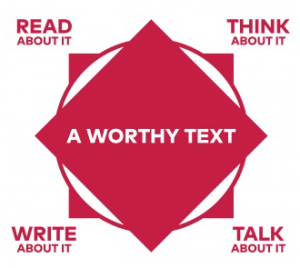I have been working on this post for about two weeks. As I’ve wrestled with it… and it has felt like a wrestling match, I’ve had to remind myself over and over again about the purpose of maintaining this blog: it is about my own learning. When I write, I am processing my own learning which is often messy and unclear. But I have found it (writing) to be critical to finding clarity around my learning. As new information comes my way, I think I understand it, but when I start to write about it or to talk about it with friends and colleagues, I find that things aren’t as clear as I believed. I’ve been surprised out how often I go back to my sources (books, websites, and notes) as I write – simply hearing and reading about new information is not enough: true understanding comes when we add a layer to the intake of information – speaking and writing about it.
The implications for the classroom in what I just described are huge. Our students deserve the opportunity to process their learning through speaking and writing, in addition to the initial intake of information through listening and reading. EL Education describes the importance of the Read, Think, Talk, Write Cycle in their language arts curriculum. I continue to see the value of this cycle in all subject areas – inside and outside of school!

Applied Educational Neuroscience
63 educators from southeast Iowa, primarily from Fort Madison Community School District, came together for two days recently to attend the Brain Institute, presented by Dr. Lori Desautels. It would be time well-spent to peruse Dr. Lori’s website: Revelations in Education. It is loaded with resources! My favorite, so far, is found on the Teacher Resources page: 6 Misunderstandings – a terrific go-to for the inevitable resistance to and questions about the validity of trauma-informed education.
Dr. Lori began our two days by doing what we all crave: she acknowledged and validated all educators. She opened by acknowledging how rough the last two years have been. Like, wow. Rough. And we can only hope that the 22-23 school year will roll out with fewer challenges than the last two school years. One of the points that Dr. Lori drove home about the last two years in education was this: We are missing the point when we keep talking about learning loss. This (pandemic years) is about loss of emotional safety.
My Attempt to Explain the Three Brain Systems
Dr. Lori Desautels’ work centers around applied educational neuroscience: understanding the brain, understanding how trauma impacts the brain, and understanding the neuroplasticity of the brain – the brain’s ability to build new connections, to “recover” from adverse experiences. At its simplest, we can think of the brain as a hierarchy of three systems: the brain stem, which is responsible for our vital functions and can be thought of as the “fight-flight” center; the limbic system – where the amygdala is located – is our emotional center; and the cerebral cortex which is where our thinking and reasoning occurs.
The prefrontal cortex is the last to “come on-line.” It comes on around ages 20 – 30. When we can get our kids to the cortex, they can learn. We, kids and adults, need to get to the cortex: adults first. We can learn brain science right alongside of our students – we don’t need to be the experts.
While reading Dr. Lori’s book, Connections Over Compliance, the message that comes across loud and clear is this: the work of Applied Educational Neuroscience (Trauma Accommodating Lens) begins with the educator (not the student, not anybody else). “Behavior management is not about the kids, it is about us.” It is about awareness of our own brain states, our preconceptions, our beliefs and values and how they influence our reactions to students, our “triggers” that lead to our own dysregulation, and awareness of strategies that work to bring us back to a regulated state. A dysregulated adult cannot regulate a dysregulated child.
Connections Abound
As I continue this journey of understanding applied educational neuroscience, I continue to see the plethora of connections to my journey of understanding the science of reading. The best way, the only way, to make positive impacts on our students is to begin with the adults. For the past year, I have heard an administrator repeat a mantra that sounds something like this: “This work [understanding our EL Education reading curriculum] is about you (the teacher). Don’t worry about the students. Take care of you.” I always knew what he meant, but now I really know what he meant: when we focus on improving our own understanding, our own well-being, our own learning, our kids’ learning, understanding, and well-being will come right along with it. I get it, Mr. Dirth. I get it. You couldn’t have been more right.
I like the Read, Think, Talk, Write Cycle.
I think trauma-informed instruction and trauma-informed classroom management are important. It is a big paradigm shift from the status quo. Our understanding of the brain will help us cross this divide in time.